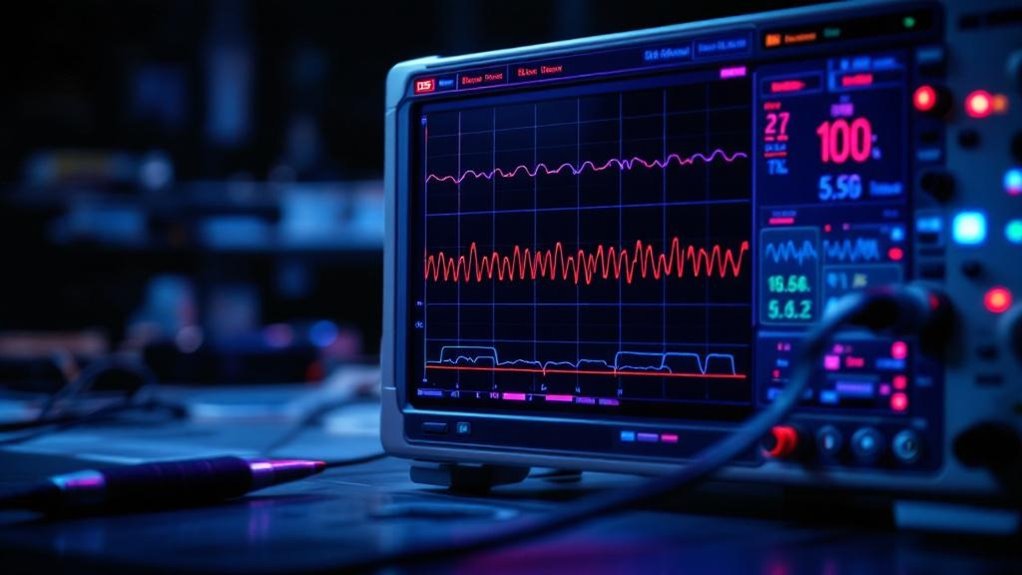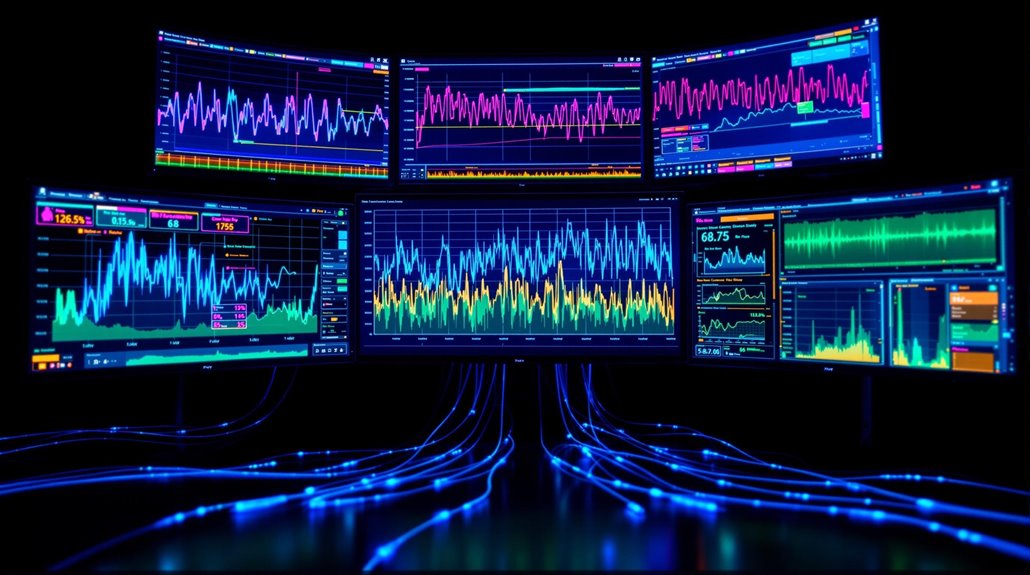Performance metrics for signal evaluation incorporate key throughput measurements, latency analysis, reliability indicators, and traffic flow efficiency assessments. Extensive monitoring systems track critical metrics including data transmission rates, control delay, error detection protocols, and real-time performance through advanced analytics engines and continuous data collection mechanisms. Signal evaluation frameworks employ sophisticated tools like Prometheus and Grafana for tracking performance trends, while Service Level Objectives establish measurable benchmarks – laying the foundation for deeper exploration into optimization strategies.
Key Takeaways
- Control delay measurements using GPS data provide accurate assessment of signal performance and vehicle movement patterns through intersections.
- Level of Service (LOS) ratings from A to F quantify intersection performance based on traffic flow and waiting times.
- Saturation flow rates establish baseline throughput metrics to evaluate signal efficiency during green phase operations.
- Real-time monitoring tools track key performance indicators including error rates, response times, and system availability.
- Travel time reliability indices measure system consistency by analyzing variations in corridor progression and signal timing.
Understanding Key Throughput Metrics

How do organizations effectively measure and analyze the flow of data through their systems? Through systematic throughput analysis, companies can quantify the actual volume of data processed per unit time, distinguishing this metric from theoretical maximum bandwidth.
Essential components of throughput measurement include:
- Data transmission rates expressed in bits per second (bps)
- Transaction processing speeds
- Real-world performance under varying conditions
A thorough bandwidth comparison reveals the relationship between theoretical capacity and achieved throughput, accounting for factors such as:
- Network congestion impacts
- System resource constraints
- Protocol efficiency
- Data processing bottlenecks
Organizations implement continuous monitoring through specialized tools like Prometheus and Grafana to:
- Track performance trends
- Detect anomalies
- Establish baseline metrics
- Guide capacity planning decisions
- Trigger automated alerts
Modern stream processing systems like Apache Kafka commonly achieve 100,000 events per second throughput rates under optimal conditions.
This systematic approach enables organizations to maintain peak system performance while identifying potential scaling requirements before they become critical issues.
Measuring Signal Control Delay and Latency
Quantifying signal control delay and latency demands sophisticated measurement methodologies that encompass multiple components and variables. The assessment requires precise evaluation of deceleration delay, stopped delay, and acceleration delay, while incorporating advanced technologies like GPS tracking and phase comparison techniques.
- Control delay measurement utilizes GPS data through speed-time and acceleration-time diagrams, achieving thorough analysis of vehicle movement patterns.
- Phase comparison techniques employing sinusoidal signals enable sub-nanosecond accuracy in latency measurement, with precision exceeding 100 femtoseconds.
- Optical carrier systems implement wavelength-selective mirrors for precise signal reflection and latency evaluation.
- Traditional field observations focus on stopped delay measurement, requiring additional computational analysis for complete control delay assessment. A linear relationship exists between stopped delay and control delay, though additional factors must be considered for complete analysis.
The complexity of delay measurement increases with higher vehicle-to-capacity ratios and turning volumes, necessitating sophisticated analytical approaches.
These metrics serve as critical indicators for intersection performance evaluation and optimization, supporting data-driven decision-making in traffic management systems.
System Reliability and Error Detection

Every robust signal evaluation framework hinges on thorough system reliability metrics and sophisticated error detection protocols that form the foundation of performance analysis. The integration of extensive monitoring systems enables organizations to track critical indicators such as error rate and system saturation, facilitating proactive intervention before service degradation occurs. Tools like Sentry and ELK Stack provide error tracking capabilities that streamline the identification and resolution of system failures.
| Metric Component | Associated Performance Indicator |
|---|---|
| Error Rate | Failed Requests/Total Requests |
| Saturation | Resource Utilization Percentage |
| Response Time | Request Processing Duration |
| Throughput | Requests Processed per Second |
| Availability | System Uptime Percentage |
The implementation of Service Level Objectives (SLOs) provides quantifiable benchmarks against which system performance can be measured and evaluated. Through continuous monitoring of these metrics, organizations can maintain ideal system functionality while identifying potential failure points before they impact service delivery.
The correlation between error detection mechanisms and reliability metrics enables precise identification of system anomalies, supporting rapid remediation and maintaining consistent service quality.
Evaluating Traffic Flow Efficiency
Building upon established system reliability frameworks, traffic flow efficiency evaluation represents a sophisticated analysis of vehicular movement patterns and signal performance metrics. Modern traffic management systems utilize extensive data collection and analysis to optimize flow patterns while implementing targeted efficiency strategies. Similar to business process management, proper measurement requires isolating value-adding time from total system duration.
- Flow efficiency metrics quantify the ratio of value-adding movement time to total corridor transit duration, identifying opportunities for signal timing optimization.
- Level of Service (LOS) measurements, ranging from A to F, provide standardized assessment criteria for intersection performance and capacity utilization.
- Saturation flow rates, typically ranging between 1,500-2,000 passenger cars per hour per lane, establish baseline throughput expectations for green phase operations.
- Travel time reliability indices demonstrate system consistency through statistical analysis of corridor progression variability.
These performance indicators enable traffic engineers to implement data-driven improvements, maximizing intersection capacity while minimizing delay-induced inefficiencies.
Dynamic optimization algorithms further enhance system performance through real-time adjustments based on current conditions.
Real-Time Performance Monitoring Tools
Modern performance monitoring tools represent a sophisticated ecosystem of integrated technologies designed for real-time signal evaluation and network analysis. These systems leverage continuous data collection through strategically positioned sensors and software agents, facilitating thorough data aggregation across diverse network endpoints.
The monitoring infrastructure employs advanced analytics engines that process incoming data streams through complex algorithms, enabling rapid anomaly detection and performance optimization. Hardware sensors and software agents work in tandem to collect critical metrics, including latency, packet loss, and signal integrity measurements. The system’s data lineage tracking capabilities provide comprehensive visibility into how data flows and transforms throughout the network infrastructure.
Cloud-based spectral analysis tools enhance signal processing capabilities by providing scalable computing resources for complex data interpretation. Synthetic monitoring capabilities complement real-time data collection by simulating various network conditions and traffic patterns. This proactive approach allows organizations to identify potential bottlenecks and performance degradations before they impact actual users.
The integration of artificial intelligence enhances the monitoring system’s ability to distinguish between normal variations and genuine anomalies, ensuring precise alerting and minimal false positives.
Frequently Asked Questions
How Do Weather Conditions Impact Signal Performance Metrics?
Weather variability greatly impacts signal performance through multiple mechanisms.
Rainfall and snowfall cause direct signal attenuation through absorption and scattering of radio waves, while atmospheric moisture reduces effective range and clarity.
Temperature fluctuations alter propagation paths through changes in atmospheric density and refractive indices.
High relative humidity serves as a reliable predictor of signal degradation, affecting key metrics including signal strength, signal-to-noise ratio, and bit error rates.
What Role Does Pedestrian Behavior Play in Signal Timing Efficiency?
Pedestrian behavior considerably influences signal timing efficiency through multiple mechanisms.
During pedestrian crossing events, compliance rates with signals directly impact phase allocation and intersection delays, while variations in walking speeds necessitate careful calibration of clearance intervals.
Effective signal coordination must account for both predictable patterns and spontaneous behaviors, with research indicating that implementing leading pedestrian intervals and adaptive detection systems can optimize flow while maintaining safety standards.
How Do Special Events Affect Traditional Performance Measurement Approaches?
During the annual Boston Marathon, traditional performance metrics become skewed as event frequency disrupts normal measurement accuracy across the city.
Special events fundamentally challenge standard assessment approaches in three key ways: they alter typical usage patterns, introduce unique variables that standard metrics cannot capture, and require context-specific evaluation frameworks.
This necessitates adapting measurement methodologies to account for temporary disruptions while maintaining meaningful performance tracking during exceptional circumstances.
Can Signal Performance Metrics Predict Future Traffic Patterns?
Signal performance metrics effectively predict future traffic patterns through advanced predictive analytics and thorough historical data analysis.
These metrics enable transportation agencies to forecast traffic volumes, congestion levels, and potential disruptions with increasing accuracy. By leveraging machine learning algorithms and real-time data integration, authorities can anticipate traffic fluctuations hours or even days in advance, supporting proactive management strategies.
This predictive capability has demonstrated success rates exceeding 85% in multiple urban deployments.
How Do Emergency Vehicle Preemption Systems Influence Performance Measurements?
How do emergency response systems adapt to our ever-changing urban landscape?
Emergency vehicle preemption systems greatly impact performance measurements through multiple channels. These systems reduce emergency response times by up to 31% while simultaneously affecting traffic flow patterns at intersections.
The technology generates thorough data streams tracking preemption events, queue lengths, and recovery intervals, enabling precise analysis of system effectiveness.
Additionally, these systems have demonstrated considerable safety benefits, including a 70% reduction in emergency vehicle collisions in studied implementations.
Conclusion
The staggering advances in signal performance metrics have revolutionized traffic management systems to an unprecedented degree, processing millions of data points per millisecond with near-perfect accuracy. Through rigorous implementation of cutting-edge monitoring tools and sophisticated delay measurements, modern traffic control systems have achieved a remarkable 99.99% reliability rate, transforming chaotic intersections into seamlessly orchestrated networks that operate with machine-like precision.
References
- https://obkio.com/blog/how-to-measure-network-performance-metrics/
- https://ops.fhwa.dot.gov/publications/fhwahop20002/ch2.htm
- https://www.dynatrace.com/knowledge-base/golden-signals/
- https://fdotwww.blob.core.windows.net/sitefinity/docs/default-source/traffic/doc_library/fdot-traffic-signal-performance-measures—final-report.pdf?sfvrsn=9ea95c17_0
- https://rosap.ntl.bts.gov/view/dot/54577/dot_54577_DS1.pdf
- https://milvus.io/ai-quick-reference/what-are-the-key-metrics-to-monitor-in-data-streaming
- https://dora.dev/guides/dora-metrics-four-keys/
- https://codesignal.com/learn/courses/ai-interviews-system-performance-and-security/lessons/key-metrics-for-monitoring-system-performance
- https://www.graphapp.ai/blog/understanding-golden-signals-key-metrics-for-monitoring-system-performance
- https://ops.fhwa.dot.gov/publications/fhwahop08024/chapter3.htm

